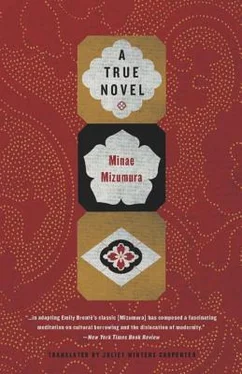Minae Mizumura - A True Novel
Здесь есть возможность читать онлайн «Minae Mizumura - A True Novel» весь текст электронной книги совершенно бесплатно (целиком полную версию без сокращений). В некоторых случаях можно слушать аудио, скачать через торрент в формате fb2 и присутствует краткое содержание. Год выпуска: 2013, Издательство: Other Press, Жанр: Современная проза, на английском языке. Описание произведения, (предисловие) а так же отзывы посетителей доступны на портале библиотеки ЛибКат.
- Название:A True Novel
- Автор:
- Издательство:Other Press
- Жанр:
- Год:2013
- ISBN:нет данных
- Рейтинг книги:4 / 5. Голосов: 1
-
Избранное:Добавить в избранное
- Отзывы:
-
Ваша оценка:
- 80
- 1
- 2
- 3
- 4
- 5
A True Novel: краткое содержание, описание и аннотация
Предлагаем к чтению аннотацию, описание, краткое содержание или предисловие (зависит от того, что написал сам автор книги «A True Novel»). Если вы не нашли необходимую информацию о книге — напишите в комментариях, мы постараемся отыскать её.
A True Novel
The winner of Japan’s prestigious Yomiuri Literature Prize, Mizumura has written a beautiful novel, with love at its core, that reveals, above all, the power of storytelling.
A True Novel — читать онлайн бесплатно полную книгу (весь текст) целиком
Ниже представлен текст книги, разбитый по страницам. Система сохранения места последней прочитанной страницы, позволяет с удобством читать онлайн бесплатно книгу «A True Novel», без необходимости каждый раз заново искать на чём Вы остановились. Поставьте закладку, и сможете в любой момент перейти на страницу, на которой закончили чтение.
Интервал:
Закладка:
When he first started coming over it was autumn by the calendar, but the days were still summery. Mrs. Utagawa would sit near the veranda with her sewing while, close by, Taro and Yoko sat at her low desk with their small heads together, doing their homework. Her room, equipped with the old furniture from the Utagawa Clinic, also had a small family altar, a porcelain hibachi with a kettle on top, and, when it turned cold, a kotatsu heater with a quilt cover. In that one room, it seemed as if time stood still, fixed at a certain year in the Showa period. I would leave the sliding doors open and sit in the adjoining room, folding the laundry or ironing. At three our little quartet—Mrs. Utagawa, Yoko, Taro, and me, not one of us related to the others—would gather in a sunny spot for the customary snack. That was the most peaceful time of the day.
When her homework was done, Yoko used to sit quietly next to her grandmother in her usual splayed-legs position and play with her dolls or gather kimono scraps or color in a coloring book. After Taro came, she was much more active. When the weather was nice, they would go out into the front yard to play. This was hidden from the Azuma house and surrounded by fields and bamboo groves that had somehow remained untouched as new houses went up all over the neighborhood. Since the yard was private, they could play there undisturbed.
There was a swing in one corner, and they took turns on it, each child being allowed a certain number of swings. As I sat in my room reading, in the distance I’d hear Yoko chanting over and over again:
Swing, swing, here comes the train.
When you hear the whistle, then we change again.
Children have such short attention spans, and yet they will cheerfully go on repeating the same thing endlessly, beyond the endurance of any adult. One day that everlasting “Swing, swing” kept up for a good hour, until finally I shut my book and went to have a look. Yoko was standing on the wooden seat while Taro pushed her from behind, her hands clutching the ropes and her feet braced, her whole body quivering with joy as she pumped her little legs for all she was worth and laughter poured out of her. When it was Taro’s turn, sometimes he got so carried away he’d swing right around, full circle.
They also bounced balls while chanting songs to the rhythm:
Tell me where you’re from, sir.
I’m from Higo, sir.
Where in Higo, sir?
Kumamoto, sir.
Where in Kumamoto, sir?
And they tried high-jumping over a long chain of elastic bands attached to trees. It was never higher than Yoko could jump—so actually low-jumping—but Taro didn’t seem to mind. They played jump-rope games too. One time Mrs. Utagawa and I were summoned to join in, everyone dancing in and out and changing places until, before I knew it, Yoko and Mrs. Utagawa were turning the rope and Taro and I were competing to see who could last the longest. I jumped so easily in my wooden clogs for such a long time that finally he said in amazement, “Fumiko, you’re the best. You’re an athlete!”
Besides the front yard, the children also played in vacant lots in the neighborhood. Their favorite one was diagonally across from our house, half hidden by what was left of an old hedge that you couldn’t see through from the street. The lot had thick clusters of tall, silvery pampas grass, and toward the back there was a small abandoned house with an air raid shelter. They dragged me there, tugging me by the hands. The dirt-floored entrance was overgrown with weeds, the raised wooden floor was full of gaps, the posts blackened in places by fire. It was a spooky place, which was exactly what the children liked about it. “The people who used to live here didn’t make it to the shelter in time and died in an air raid, so ghosts come out right in the daytime,” Yoko would say in a scary voice, and then Taro, hiding somewhere, would make an ominous sound, trying to frighten me. A shrine only ten minutes from there had a little playground in one corner where they could have fun on the slide and teeter-totter. Many were the times Yoko came home with dirt stains on her skirt.
When the weather was bad, they romped around the house. Looking on, it wasn’t always easy to say just what kind of game they were playing. Natsue was of the firm opinion that girls needed to sit on chairs, not on the floor, and sleep on proper beds at an early age or else they’d grow up “with those awful, bent Japanese legs”; so not long after Taro started coming to the house, two bedsteads showed up in the sisters’ tatami room—and were promptly used for games. Unlike the beds in Karuizawa, which had only straw mattresses on iron frames, these had actual springs. Yoko loved them. She and Taro would perch side by side, one at the foot of each bed, and bounce up and down as if holding reins in their hands, pretending to be stagecoach drivers. Sometimes they put what looked like scrolls in their mouths, tied long cloths to their backs, and jumped down the stairs to land on a heap of cushions at the bottom—like ninja or Superman, I couldn’t tell which. Other times they would line up the dining room chairs and teeter across, as if inching across a hanging bridge over a great ravine. For all I know they thought they were tiptoeing under towering cliffs wrapped in spring mist, with wild, thundering rapids below, but all I could see as I whipped around getting dinner on the table was the room in a shambles.
Now and then they would sneak into Takero’s study and play “English,” typing random letters on the typewriter there. They also played “poor family,” imagining that the tiny playroom was their house. Where she had picked up such notions I have no idea, but Yoko would announce, “There’s no more rice in the cupboard; I must go to the pawnshop,” and begin tying up one of her grandmother’s kimonos in a wrapping cloth. As Taro was genuinely poor, it always made me smile to see him play along with this, looking quite serious.
Before he came on the scene, Yoko used to enjoy typical girlish pastimes like making multicolored braids of silk yarn, flipping tiny ohajiki disks, or playing house. But Taro had never had any boys for playmates, let alone any toys of his own, so he knew nothing about marbles, cards, or tops. One day when I went out to do the marketing, I saw a boy his age by the hardware store playing cleverly with a kendama peg-in-the-hole, and I decided on the spur of the moment to stop at a toy store on the way home and pick one up for Taro. I handed it to him with instructions to keep it a secret from Mrs. Utagawa, who, I thought, would disapprove of a lowly little toy like this, but sharp-eyed Yoko spotted it right away. “Oo look, a peg-in-the-hole!” she shouted, and promptly showed it to her grandmother. After that they played with the toy openly in front of her, with instructions to keep it secret from Natsue instead. Yoko soon tired of the toy, but Taro, whose coordination was much better to begin with, would go on practicing for so long that she’d get bored and pout. Soon he could do tricks with the effortless skill of a circus performer. It made me think how much boys his age would have looked up to him if he had ever played with them. But Taro himself seemed to enjoy just being at Yoko’s beck and call.
One day the elder girl, Yuko, found the toy hidden away in the back of a drawer in the playroom. “Hey, look what I found!” Fortunately, she didn’t tell her mother. Her sister, Yoko, was a chatterbox, but she kept quiet about things that really mattered to her, and never told Yuko anything about Taro. Even so, perhaps because the girls were so close in age, Yuko seemed to know intuitively what was going on. She certainly had a better idea than Natsue of what was happening while the two of them were out.
Читать дальшеИнтервал:
Закладка:
Похожие книги на «A True Novel»
Представляем Вашему вниманию похожие книги на «A True Novel» списком для выбора. Мы отобрали схожую по названию и смыслу литературу в надежде предоставить читателям больше вариантов отыскать новые, интересные, ещё непрочитанные произведения.
Обсуждение, отзывы о книге «A True Novel» и просто собственные мнения читателей. Оставьте ваши комментарии, напишите, что Вы думаете о произведении, его смысле или главных героях. Укажите что конкретно понравилось, а что нет, и почему Вы так считаете.












